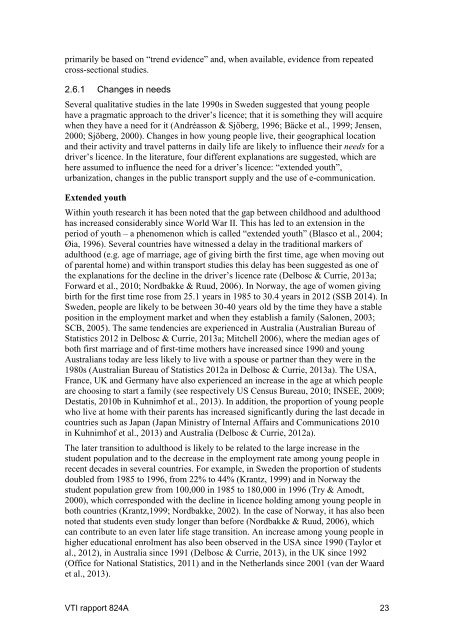utvecklingen-av-korkortsinnehav-bland-unga-mojliga-forklaringar-konsekvenser-och-trender
utvecklingen-av-korkortsinnehav-bland-unga-mojliga-forklaringar-konsekvenser-och-trender
utvecklingen-av-korkortsinnehav-bland-unga-mojliga-forklaringar-konsekvenser-och-trender
Create successful ePaper yourself
Turn your PDF publications into a flip-book with our unique Google optimized e-Paper software.
primarily be based on “trend evidence” and, when <strong>av</strong>ailable, evidence from repeatedcross-sectional studies.2.6.1 Changes in needsSeveral qualitative studies in the late 1990s in Sweden suggested that young peopleh<strong>av</strong>e a pragmatic approach to the driver’s licence; that it is something they will acquirewhen they h<strong>av</strong>e a need for it (Andréasson & Sjöberg, 1996; Bäcke et al., 1999; Jensen,2000; Sjöberg, 2000). Changes in how young people live, their geographical locationand their activity and tr<strong>av</strong>el patterns in daily life are likely to influence their needs for adriver’s licence. In the literature, four different explanations are suggested, which arehere assumed to influence the need for a driver’s licence: “extended youth”,urbanization, changes in the public transport supply and the use of e-communication.Extended youthWithin youth research it has been noted that the gap between childhood and adulthoodhas increased considerably since World War II. This has led to an extension in theperiod of youth – a phenomenon which is called “extended youth” (Blasco et al., 2004;Øia, 1996). Several countries h<strong>av</strong>e witnessed a delay in the traditional markers ofadulthood (e.g. age of marriage, age of giving birth the first time, age when moving outof parental home) and within transport studies this delay has been suggested as one ofthe explanations for the decline in the driver’s licence rate (Delbosc & Currie, 2013a;Forward et al., 2010; Nordbakke & Ruud, 2006). In Norway, the age of women givingbirth for the first time rose from 25.1 years in 1985 to 30.4 years in 2012 (SSB 2014). InSweden, people are likely to be between 30-40 years old by the time they h<strong>av</strong>e a stableposition in the employment market and when they establish a family (Salonen, 2003;SCB, 2005). The same tendencies are experienced in Australia (Australian Bureau ofStatistics 2012 in Delbosc & Currie, 2013a; Mitchell 2006), where the median ages ofboth first marriage and of first-time mothers h<strong>av</strong>e increased since 1990 and youngAustralians today are less likely to live with a spouse or partner than they were in the1980s (Australian Bureau of Statistics 2012a in Delbosc & Currie, 2013a). The USA,France, UK and Germany h<strong>av</strong>e also experienced an increase in the age at which peopleare choosing to start a family (see respectively US Census Bureau, 2010; INSEE, 2009;Destatis, 2010b in Kuhnimhof et al., 2013). In addition, the proportion of young peoplewho live at home with their parents has increased significantly during the last decade incountries such as Japan (Japan Ministry of Internal Affairs and Communications 2010in Kuhnimhof et al., 2013) and Australia (Delbosc & Currie, 2012a).The later transition to adulthood is likely to be related to the large increase in thestudent population and to the decrease in the employment rate among young people inrecent decades in several countries. For example, in Sweden the proportion of studentsdoubled from 1985 to 1996, from 22% to 44% (Krantz, 1999) and in Norway thestudent population grew from 100,000 in 1985 to 180,000 in 1996 (Try & Amodt,2000), which corresponded with the decline in licence holding among young people inboth countries (Krantz,1999; Nordbakke, 2002). In the case of Norway, it has also beennoted that students even study longer than before (Nordbakke & Ruud, 2006), whichcan contribute to an even later life stage transition. An increase among young people inhigher educational enrolment has also been observed in the USA since 1990 (Taylor etal., 2012), in Australia since 1991 (Delbosc & Currie, 2013), in the UK since 1992(Office for National Statistics, 2011) and in the Netherlands since 2001 (van der Waardet al., 2013).VTI rapport 824A 23


